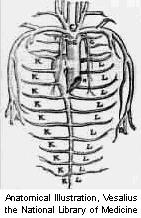Renaissance Medicine
The Renaissance
stimulated medical practice just as it did all other European intellectual
pursuits. Physicians and scholars began to scientifically study medicine.
Many began to research human anatomy. Their discoveries corrected
many of the errors that had gone undetected for centuries and were rapidly
disseminated through the new invention of printing. Andreas Vesalius was
the premier anatomist of this age and published many illustrations of his
discoveries. Arabic pharmaceutical practices were studied and improved,
and medicines--like laudanum--were developed to stop or reduce pain.
Some doctors began to investigate the spread of infectious diseases.


Surgical procedures were also modernized, many as the direct result of
battlefield experiences. Surgeons began to experiment with ways to ease
the suffering of their patients. Amboise Pare revolutionized surgery when
he began to use ligatures to stop bleeding wounds instead of cauterizing
them with boiling oil or red-hot pokers.
Back to
Index



